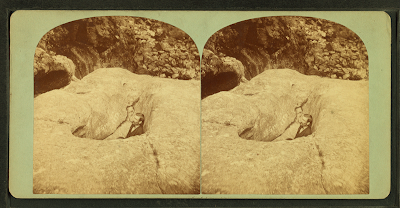In the town of Beverly, Massachusetts is a large wooded conservation area officially called Beverly Commons, but which has also been know for many years as Witches Woods. The story most currently told about the name is that Giles Corey supposedly hid out in these woods while trying to escape from the Salem witch trials. I'm not sure how true that story is. Giles Corey was quite elderly when he was accused of witchcraft and it wasn't easy to get from Salem Village to Beverly back in the 1600s. Still, it's a good story.
Even better stories about Witches Woods can be found in Caroline Howard King's When I Lived in Salem, 1822 -1866. This book, which is a collection of reminiscences about daily life on the North Shore in the early 19th century, is fascinating. Do you want to know what people ate for dessert in 1836? Marlborough pudding and cranberry pie, of course. What happened to a woman if she fell asleep during the interminable Sunday church services? A church official called the Tidy Man (aka the Tithing Man) would tickle her awake with a fox-tail mounted on a pole. Drowsy men weren't treated so gently - they were whacked back into consciousness with a wooden knob mounted on the other end.
Caroline Howard King's family owned a summer home in Beverly called Thisselwood, which abutted Witches Woods. She doesn't mention any stories about witches, but does write about some other spooky occurrences happening in the area.
 |
| Thisselwood, from the Harvard University Library. |
She never did see the decapitated ghost, but had instead another odd experience in Witches Woods. One summer morning in 1841 Caroline (who was nineteen at the time) set off for a stroll in Witches Woods with her nine-year old cousin Nony and a maid named Lucy Anne. After walking for while the group decided to have a snack and rest under some hemlock trees a short distance from the path. When they were done eating they walked back to the path - but it wasn't there. Despite searching in all directions no path could be seen at all. It was if it had vanished.
Caroline and her companions wandered through the woods for hours, but somehow always came back to the exact same spot. They could hear the ocean and knew they weren't far from home but were unable to get there.
Trying one last time to find the path they stumbled upon a clearing in the woods, in the middle of which stood the remains of a long-abandoned house: a chimney, a cellar-hole, and a stone stoop with an enormous lilac bush growing next to it. This ruin, Caroline knew, was called by her neighbors the Homestead, and was shunned and said to be haunted.
A path led from the clearing up a small hill, and the group decided to follow it. From the top of the hill they had a view over the woods, and could see nearby at the foot of the hill a cozy farmhouse with smoke rising from the chimney. The house had a broad stone stoop, and as they watched a woman came outside and scattered feed for the chickens. Excitedly, Lucy Anne ran down towards the house to ask for directions home.
Caroline and her cousin waited, and waited, and finally a dejected Lucy Anne returned. No matter how many times she had walked around the hill she couldn't find the farmhouse. In fact, all she saw were "hateful solemn old pine trees." However, she had found a dry stream bed which they followed out of the woods to the beach and eventually home to Thisselwood.
 |
| James Russell Lowell, from Wikipedia. |
The writer James Russell Lowell was staying with the King family at the time. Lowell claimed he had the second sight and had seen a ghost at Elmwood, his family's estate in Cambridge (now the home of Harvard University's president), so he set off into the woods determined to find the haunted farm. He never found either the abandoned ruin or the elusive farmhouse (which was clearly a ghostly image of the ruin as it formerly appeared).
What would have happened if he or Lucy Anne actually had found the house and asked the farm wife (if that's what she was) for directions? What if they went inside for a drink of water or a bite to eat? I think they should be thankful they never found they house, because fairy tales and ghost stories suggest they might still be inside today.






























.jpg)






